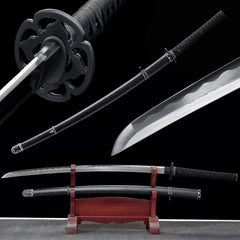The Nagamaki
3 minute read
Believed to be first introduced in the Heian Period (794 to 1185), the nagamaki was a Japanese sword carried by many Samurai. The blade was forged to take down larger enemies and attack from a long-range. Discover how the nagamaki became a staple sword for Samurai living in feudal Japan, courtesy of American BladesPro.
Origin
Although historians believe the blade was initially forged during the Heian Period, the nagamaki became widely used across the Muromachi Period (1336-1573). Based on its appearance, many scholars think the sword is a variant of the odachi which was one of the first longswords forged in Japan. Feudal warlord, Uesugi Kenshin who was the daimyo of the Echigo Province, had an elite unit of guards that wielded the Japanese longsword protecting the throne. Kenshin was renowned for his skilful swordsmanship and believed the nagamaki was one of the most effective weapons of his time.

A Japanese painting of famous daimyo, Uesugi Kenshin.
Dimensions and Uses

Just like the nagamaki, tachi swords have an exceptional curved blade. Check out our elite collection of Tachi Samurai Swords by following the link.

If you've enjoyed reading about the nagamaki, you might want to get your hands on one of its predecessors, the odachi. At American BladesPro we have the finest range of Odachi Swords, follow the link to view our blades.
To correctly wield the nagamaki, you must place both hands on its hilt and perform broad slicing strokes. Considering its power and ability to do damage from a long distance, the sword was often used to bring down cavalry on the battlefield.
References in Popular Culture
Despite the nagamaki being forged during feudal times, the famous blade has been referenced in modern popular culture on many occasions. Successful video game, Dark Souls II, included a character named Sir Alonne who uses the nagamaki against players during a boss fight.
Another franchise that referred to the nagamaki was the first two Lord of the Rings movies, The Fellowship of the Ring and The Two Towers. In these films, the elves use a longsword that looks like a modified version of the nagamaki. Unlike the traditional design, the swords the elves use has a larger arc along its blade.
Other videos games such as, Sekiro: Shadows Die Twice, Suikoden and Samurai Spirits have all produced characters that wield the nagamaki.
The Nagamaki's stylish blade, rich history and relevance in popular culture has made it a timeless gem that will feature in many years to come.
